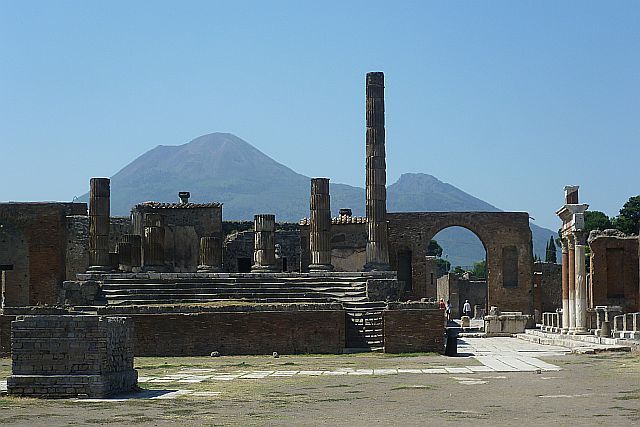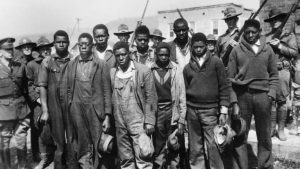During the First Century, war and illnesses were common killers in the Roman Empire. However, in the year 79 CE, Mount Vesuvius would show the city of Pompeii that a natural disaster could bring as much devastation and destruction as anything else.
In the decades before Mount Vesuvius engulfed Pompeii in ashes, an earthquake had struck the region. While the earthquake did not devastate the region, people there did not comprehend the amount of death and destruction that a natural disaster was capable of. In 79 CE, the beautiful and thriving city of Pompeii in the Roman Empire was a popular location for the wealthy and merchants to flock to. Historians have placed the population of Pompeii and neighboring region between 10,000 and 20,000 people. 1 Unfortunately, in the month of August, the city of Pompeii would be transformed from a jewel to ruins by one of the most powerful and devastating natural forces: a volcanic eruption.

Although nature provided warning signs of the catastrophic event that would soon follow, people were not able to comprehend them. Animals were dying because of their lungs being filled with toxic gas, a strong odor filled the countryside of Pompeii, and worse of all, earthquakes rattled the ground below as a result of the pressure from the magma.
On the morning of August 24, 79 CE, a strong blast from Mount Vesuvius that resulted in smoke arising from the crater drew people’s attention to the volcano, but the people of Pompeii did not panic or evacuate. Worse was yet to come. Around noon, the second explosion took place. This explosion was much stronger. A mushroom cloud shot into the sky at a distance of 27 miles. The explosion was estimated to be 100,000 times stronger than the bomb dropped on Hiroshima.2
The eruption that caused the mushroom cloud was so strong that it could have been witnessed hundreds of miles away. Pliny the Younger, an eyewitness, was so horrified and amazed by the cloud that he could not help but describe it in awe:
A cloud, from which mountain was uncertain, at this distance (but it was found afterwards to come from Mount Vesuvius), was ascending, the appearance of which I cannot give you a more exact description of than by likening it to that of a pine-tree, for it shot up to a great height in the form of a very tall trunk, which spread itself out at the top into a sort of branch.3
For those who decided not to flee Pompeii in the wake of the eruption, death was almost certain. As the eruption lasted a day, every passing hour meant more ash and toxic gas. If somehow people managed to survive breathing the toxic gas, the volcanic ashes were sure to kill them. Since structures in Pompeii were not built to carry as much weight as the ash covering them, many structures collapsed, resulting in the deaths of people who found refuge in them.
By the time Mount Vesuvius stopped ejecting ash and toxic gas into the air, ash covered Pompeii. The entire city of Pompeii was gone. What once was a vibrant city was reduced to a pile of ash. In fact, to this day a third of the city remains in ash. Although Mount Vesuvius has not erupted since 1944, an eruption is imminent; hopefully the destruction of the next eruption will not be as severe as the one in 79 CE.
- Encyclopedia Britannica, September 2016, s.v. “Pompeii Ancient City, Italy,” by Wilhelmia Feemster Jashemski. ↵
- Encyclopedia Britannica, September 2016, s.v. “Pompeii Ancient City, Italy,” by Wilhelmia Feemster Jashemski. ↵
- Charles W. Eloit, The Harvard Classics Volume 9 (New York: P.F. Collier & Son. 1909-10), 285. ↵



68 comments
Clarissa Bustamante
Before reading this article I didn’t know what exactly what happened to Pompeii; all I knew was that it was a historical city. It was great how descriptive you were with the volcanic eruption and how the eruption affected the people around Pompeii. I liked how you use a quote from someone who was actually there experiencing the disaster. I feel like it gave your article more truth as to what happened at the time.
Edward Cerna
This was a great article that I found very interesting. Nobody knew the warning signs back then which is why many of them did not evacuate when the ground started shaking and such. I know that bodies covered in ash have been found and it must’ve been truly horrifying seeing everything unfold before you which Is why I like how you put the eyewitness statement in there. It is hard to comprehend how it was 100,000 times stronger than the bomb dropped on Hiroshima, It is really mind boggling.
Marco Picardo
A well written article that captures the true threat natural disasters can pose on its surroundings. I never knew the severity and power of the eruption. To think that it was 100,000 times stronger than the bomb dropped on Hiroshima is mind-boggling to say the least. One could only imagine the terror these people must have felt, especially having little to no knowledge of volcanic eruptions.
Megan Barnett
I am not very familiar with this tragic event that happened in Pompeii but I have heard of it before. It was described very well with the time frame you used to show how the eruption progressed, which really helped me understand more. I am curious though as since the eruption could have been seen hundreds of miles away where was Pliny the Younger when he witnessed it? Also in referring to your last statement I was wondering if there are many inhabitants in that area of Mount Vesuvius today, and if so is that much damage even possible?
Lianna Ybarra
I remember learning about this in high school and hearing my teacher talk about the cloud that covered the entire city. It’s scary to think that this can happen again, but if I remember correctly they said it couldn’t be for another thousand years or so. What I don’t understand is how and why people wouldn’t leave for their safety, instead they stayed and what happened to them was unfortunate.
Nicolas McKay
That was a great article Yesenia! It is sad to think that all of the warning signs were there, yet so many people died because they didn’t know how to interpret them yet. I can only imagine the absolute terror those people must have felt as they died from a force completely unheard of till then. Its is also sad to think such a magnificent jewel of a city could so quickly be reduced to rubble.
Johnanthony Hernandez
Interesting article, I’ve always wondered what must have been going through the minds of the citizens of Pompeii when Mount Vesuvius erupted. Life was normal for them like any other day and then in an instant everyone and everything was petrified in hot volcanic ash that froze them doing their daily action. It makes me wonder what would happen, what would be the damage and reaction if a similar situation occurred today. It’s hard to think that they just instantly froze doing everything that they normally did, eating, playing, and doing their daily work.
Zaraly Frasquillo
Whenever I think of the story of Pompeii I remember the scene in the film Night at the Museum in where Owen Wilson and Steve Coogan are in Pompeii and they have no clue as to why all the other Romans are running away, and then they find out its because they are in POMPEII.. (lol) I thought was really fascinating and I was hooked. I couldn’t stop reading it. My favorite part of your article has to be in where you put in an eyewitness description of the explosion, it just made your article stand out! Good job !
Samuel Sanchez
Great article. I did not know much of the story of Pompeii other than it was destroyed. I liked how you put a quote in the article describing the disaster that occurred. It gave an insight on how horrific the destruction was. There was no way of surviving there were so many factors that were going to kill the people. Comparing the explosion to the bomb that was dropped on Hiroshima was a good representation on what the explosion looked like even though in their sake it was a lot stronger. Keep up the good work.
Luke Trevino
Overall very great essay! Very well researched as well. I had no idea that it was worst that the atomic bomb. That number of people that died was devestating. In the world today we would of known to leave because of the signs of the volcano but back then they never knew something was wrong. All in all, this essay kept me wanting more it was very well written.